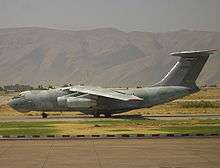2003 Iran Ilyushin Il-76 crash
The 2003 Iran Ilyushin Il-76 crash occurred on 19 February 2003, when an Ilyushin Il-76 crashed in mountainous terrain near Kerman in Iran. The Aerospace Force of the Army of the Guardians of the Islamic Revolution aircraft, registration 15-2280, was flying from Zahedan to Kerman when it crashed 35 kilometres (22 mi; 19 nmi) southeast of Kerman.[1] The aircraft was carrying members of the Islamic Revolutionary Guard, a special force that is independent from the Iranian Army, on an unknown mission.[2]
 An Ilyushin Il-76 similar to the one involved in the accident | |
| Accident | |
|---|---|
| Date | 19 February 2003 |
| Summary | Controlled flight into terrain due to pilot error during descent in bad weather |
| Site | 35 km (22 mi; 19 nmi) SE of Kerman |
| Aircraft | |
| Aircraft type | Ilyushin Il-76MD |
| Operator | Aerospace Force of the Army of the Guardians of the Islamic Revolution |
| Registration | 15-2280 |
| Flight origin | Zahedan Airport |
| Destination | Kerman Airport |
| Occupants | 275 |
| Passengers | 257 |
| Crew | 18 |
| Fatalities | 275 |
| Survivors | 0 |
Strong winds were reported in the region of the crash when the aircraft disappeared from the radar screens; approximately at the same time, villagers in the area described hearing a loud explosion.[3] There were no survivors among the 275 occupants on board the aircraft.[1][nb 1]As of January 2020 the crash remains the second deadliest on Iranian soil (behind Iran Air Flight 655) and the deadliest crash of an Il-76.[1]
Accident
The IL-76 was flying a route from Zahedan Airport to Kerman Airport carrying members of the Islamic Revolutionary Guard Corps on an unspecified mission. The four-engine Russian transport aircraft with a crew of 18, lost contact with air traffic control at 5:30 pm after flying into poor weather conditions.
The aircraft crashed into the Sirch mountains, southeast of Kerman, about 500 miles southeast of Tehran, killing all aboard. Investigators believe it was a controlled flight into terrain, citing the deteriorating weather conditions and high winds.[1][5]
Recovery and aftermath
Immediately after the crash, members of the Revolutionary Guards and Red Crescent were sent to the accident scene. Two helicopters attempting to reach the scene turned back due to bad weather.[6] A cordon of the area was completed as well, limiting access to journalists and the public.[5][7]
President Mohammad Khatami's cabinet sent a message of condolence to families of the victims about the tragic event in which a group of IRGC brothers—Islamic Revolutionary Guards Corps—were killed.[8] The Iranian government also blamed U.S. sanctions against Iran for playing a part in the crash since the restrictions make it more difficult for Iran to maintain its aircraft.[9]
There was speculation that the accident was the result of a mid-air collision due to the high number of fatalities (the Il-76 normally carries fewer than 200 passengers). A terrorist organization called the Abu-Bakr Brigades also claimed responsibility for the crash.[10]
See also
- 2005 Iranian Air Force C-130 crash
- 2018 Algerian Air Force Il-76 crash
- Charkhi Dadri mid-air collision, involving an Il-76 and a Boeing 747; and with a higher loss of life
Notes and references
References
- Accident description for 15-2280 at the Aviation Safety Network. Retrieved on 24 November 2014.
- "Fog halts Iran air crash search". CNN. 20 February 2003. Archived from the original on 4 February 2007.
- "Iranian plane crash kills 302". CNN. 19 February 2003. Archived from the original on 29 August 2007.
- "Iran plane crash kills 302". BBC News. 20 February 2013. Archived from the original on 12 July 2013.
- Chan, Sue (19 February 2003). "302 Dead in Iranian Plane Crash". CBS News. Retrieved 10 January 2018.
- Fathi, Nazila (21 February 2003). "Storm Hinders Iranian Crews Sent to Search Site of Crash". The New York Times. ISSN 0362-4331. Archived from the original on 12 February 2014. Retrieved 11 July 2019.
- "No survivors in Iran plane crash". BBC News. 20 February 2003. Archived from the original on 12 July 2013. Retrieved 11 July 2019.
- Fathi, Nazila (20 February 2003). "302 Killed in Crash of Iranian Military Plane". The New York Times.
- "Iran air safety hit by sanctions". BBC NEWS. 6 December 2005.
- "RFE/RL Iran Report". IranReport. globalsecurity.org. 24 February 2003. Archived from the original on 21 July 2009.